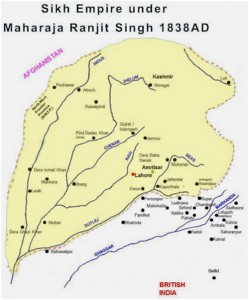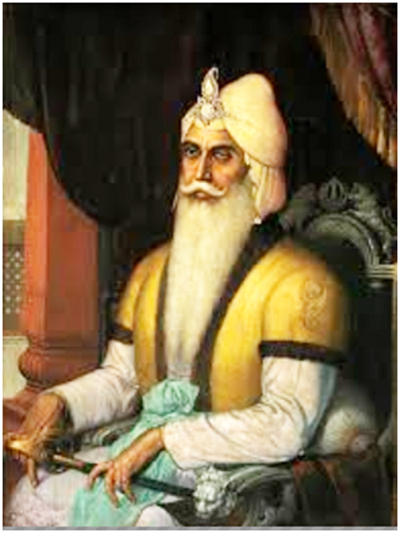S Charandeep Singh
Maharaja Ranjeet Singh, gloriously known as ‘Sher-e-Punjab’ and ‘Napoleon of the East’ besides many other titles, was a commander with unmatchable administrative, diplomatic and strategic skills. Being a great warrior, fearless soldier, clement ruler, statesman and a liberator, he routed and demolished the enemies with his sheer grit, perseverance, meticulous planning and military acumen. He was enlisted as an “undefeated military commander’ as he never lost any significant engagement against the enemy as the ‘Commander-in-Chief’ of his military force making the historian Griffen Lepel write the following about him:
”He was a born ruler, men obeyed him with instinct and because they had no power to disobey”
 He was born in Gujranwala (now in Pakistan) on 13th Nov.1780 to Mahan Singh (Commander of Sukerchakia Misl of west Punjab) and Mai Raj Kour (Daughter of king of Jind). He learnt riding, shooting and had all the tastes of nobility at an early age but he remained without formal education. Ranjeet Singh fought his first battle against Sahib Singh Bhangi, leader of the Gujarat estate (now in Pakistan) at the age of ten which instilled in his comrades the belief that a new king Commander was born. Ranjeet Singh took over the reins of the Sukerchakia Misl after the death of his father in 1792.
He was born in Gujranwala (now in Pakistan) on 13th Nov.1780 to Mahan Singh (Commander of Sukerchakia Misl of west Punjab) and Mai Raj Kour (Daughter of king of Jind). He learnt riding, shooting and had all the tastes of nobility at an early age but he remained without formal education. Ranjeet Singh fought his first battle against Sahib Singh Bhangi, leader of the Gujarat estate (now in Pakistan) at the age of ten which instilled in his comrades the belief that a new king Commander was born. Ranjeet Singh took over the reins of the Sukerchakia Misl after the death of his father in 1792.
Maharaja Ranjeet Singh was instrumental in uniting Misls and keeping them under one command of Sarkar-e-Khalsa. It is pertinent to mention that during the 18th century, states of the Sikh confederacy rose in the Punjab region of the Indian subcontinent, which considered themselves as partners in each enterprise, the associations were called Misls, of which twelve originally enumerated. The Misls formed a commonwealth that was described by the historian Antoine Polier, as an “Aristocratic Republic” under Ranjeet Singh.
Before the emergence of Maharaja Ranjeet Singh on the political scene, the situation in Punjab and Sind region presented a picture of chaos and confusion. Peshawar and Kashmir though under the suzerainty of Afghanistan had attained de facto independence. The edifice of Ahmed Shah Abdali’s empire of tyrannical Afghan rule in India had crumbled. Pathans were ruling Kasur and Nawab Muzaffar Khan had taken the charge of Multan.
Maharaja Ranjeet Singh rose as the saviour of the people and never allowed Afghanis to conquer his territory. When Shah Zaman, grandson of Ahmed Shah Abdali, succeeded to the throne of Kabul in 1793, he came up to Hassan Abdal but was defeated by Ranjeet Singh and his forces. He attacked again in 1796 and 1798 after getting support from Wazir of Oudh, Sahib of Patiala, Tipu sultan of Mysore and Raja Sansar Chand of Kangra but he got a humiliating defeat in the hands of Ranjeet Singh. The Afghans struggled hard to dislodge Sikhs but under Ranjeet Singh’s command they made Afghans impossible to proceed towards Delhi. Ranjeet Singh became the hero of land of five rivers.
Ranjeet Singh’s expansionist designs now knew no bounds, he marched on to Jammu where Maharaja of Jammu neither had any intention nor was capable of fighting so he presented him nazrana of 20,000 rupees. Ranjeet Singh marched towards Sialkot, Dilwargarh and accepted nazrana there too. Ranjeet Singh’s expansionist policies perturbed the Governor General too, who deputed Mir yousaf Ali to Lahore to hold negotiations with him which Ranjeet Singh strategically tackled, and thus he never allowed Britishers to cross Sutlej River.
On April 12, 1801, Ranjeet Singh declared himself as Maharaja of Punjab. Investiture ceremony was performed by Sahib Singh Bedi, who was the direct descendent of Guru Nanak Dev ji. In 1802, he marched towards Amritsar and captured it from the hands of Bhangi forces. He gave ‘Darbar Sahib’ marble face and embellished it with gold and thus gave it the golden look from which the name Golden temple or Swarn mandir has been derived. He also issued coins and put the word “Akal Sahai” on them as a devout Sikh.
Peshawar was occupied on Nov 18, 1818 and Ranjeet Singh appointed Jahandad Khan of Attock as the Governor of Peshawar but it was again captured by Yar Mohammad Khan. Ranjeet Singh deputed Prince Sher Singh and Hari Singh Nalwa along with Phula Singh who fought valiantly on the way from Lahore to Peshawar putting the pathans in shock. This Sikhs Victory at ‘Battle of Naushera’ liquidated afghan supremacy between Indus and Peshawar.
After the treaty of Amritsar, when the international boundary between the Sarkar-e-Khalsa and British India was established, Ranjeet Singh was virtually made master of all the territory to the west of Sutlej. Ranjeet Singh marched towards Kangra where Desa Singh Majithia was appointed Governor of kangra. Then under the command of Hukama Singh Chimmi and Hari Singh Nalwa, Ranjeet Singh dispatched forces to Jammu and Kashmir respectively. During this period Wafa begum wife of Shah Shuja pleaded before Ranjeet Singh to free his husband from Afghani Ata Muhammad and to get the throne of Kabul, in return Maharaja asked for the diamond ‘Kohinoor’ which was earlier looted by Nadir shah and held by them. Hari Singh nalwa along with the forces were dispatched who entered Kashmir towards close of 1812 and rescued Shah Shuja who as committed gave the rare diamond ‘Kohinoor (in Persian known as “Mountain Of light”) to Maharaja Ranjeet Singh.
After this victory, Hari Singh Nalwa was made the Governor of Kashmir. Ten successive Governors administered Kashmir during Sikh regime. One of them was Prince Sher Singh who sent General Zorawar Singh to conquer the strategically important Ladakh valley which he successfully conquered after fighting valiantly. Attock was annexed to the Sikh empire in 1813, Multan in 1818, Kashmir in 1819 and Rawalpindi in 1820.Maharaja Ranjit Singh’s Empire extended from the Khyber Pass in the west, to Kashmir in the north (touching) the border’s of Tibet, to the Sind River in the south and in the east to Himachal Pradesh.
The Sikh Empire was idiosyncratic as it allowed men belonging to all religions to rise to commanding positions of authority. Administration under Sikh rule was purely meant for the well being of all subjects. For administering the provinces of Multan, Kashmir and Peshawar Nazims or Governors were appointed. In Lahore province kardars (sub- divisional administrators) were appointed parganah wise. Nazim (Governor) of a province was responsible for the entire administration. The Maharaja would often tour the length and breadth of his entire kingdom and would enquire from headmen of villages about the affairs of administration and conduct of his officials. Maharaja Ranjeet Singh did not make any significant change in the assessment of land revenue. According to custom of the age, one third and a half of the produce was taken as land rent or revenue. Many a time’s money was given to the tiller of land from the royal treasury as agricultural loans. There was a standing order that no creditor could attach peasants’ cattle, produce or plough for recovery of a loan.
Baron Charles Hugel and Victor Jacquemont, the German and French travellers of his time had recorded his territories as safer than the ones ruled by the British and praised him as an inquisitive man and a benevolent king who despite having Sikh governance proved as the most secular king. With men of different races, nationalities and faiths to serve him, Ranjeet Singh maintained a most picturesque and cosmopolitan court. Ranjeet Singh had also engaged large number of Europeans, Americans, and Russians in his armies. Few of the renowned ones were Mr. Ventura, an Italian, General Jean Allard, a Frenchmen and Dr.Benet, the surgeon General of Khalsa army.
History lost this most commanding Maharaja on June 27, 1839. By that time Britishers had taken over the whole of India except Punjab and Sind. Maharaja’s status, influence and his persona can be gauged from the letter that W.G. Osborne, military secretary to the Earl of Auckland, Governor General of India wrote on July 12th, 1839 as an account of the funeral obsequies of Ranjeet Singh,
“Ranjeet Singh is dead! And died as like the Lion as he had lived. He preserved his senses to the last, and was obeyed to the last by all his chiefs. I tell you that two hours before he died he sent for all his jewels, and gave the famous diamond, called the ‘Mountain of light” said to be the highest in the world, to a Hindu temple, his celebrated string of pearls to another, and his favourite fine horses with all their jewelled trappings, worth £ 300,000,to third…….”
Maharaja Ranjeet Singh who practiced the ethos of secularism and socialism in right earnest still remains in the hearts and minds of the people whose recent testimony is the installation of his statue at Allard Square of St Tropez in France, the birthplace of General Jean Franquis Allard who served in Maharaja’s army.
(The author is a KAS officer)


